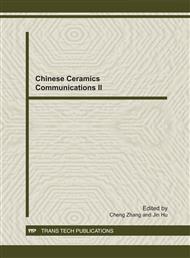p.183
p.187
p.191
p.195
p.199
p.203
p.207
p.211
p.215
Preparation and Characterization of Meso-Porous Alumina Spheres
Abstract:
Mesoporous alumina is usually used as adsorption material, catalyst carrier or separation media due to its high adsorption and good thermal stability. However, the nanosized powder trends to aggregation except that its size is in sub-micron scale. The best choice is that the sub-micron alumina particles with mesoporous structure are prepared. In the present work, the mesoporous alumina spheres were prepared by micro emulsion method using aluminium isopropoxide as raw material and water/dimethylbenzene emulsion as reaction media. The obtained powder was characterized by XRD, TEM and BET. The results show that the particles are global. The particles size is in the range of 100 ~ 200 nm to several micrometers. The particle owns the worm-like structure with the pore size of 5 nm. The BET surface area of the mesoporous alumina is 81.8 m2/g. The obtained powder is suit to be used as the packing material in chromatograph.
Info:
Periodical:
Pages:
199-202
Citation:
Online since:
November 2011
Authors:
Keywords:
Price:
Сopyright:
© 2012 Trans Tech Publications Ltd. All Rights Reserved
Share:
Citation:


